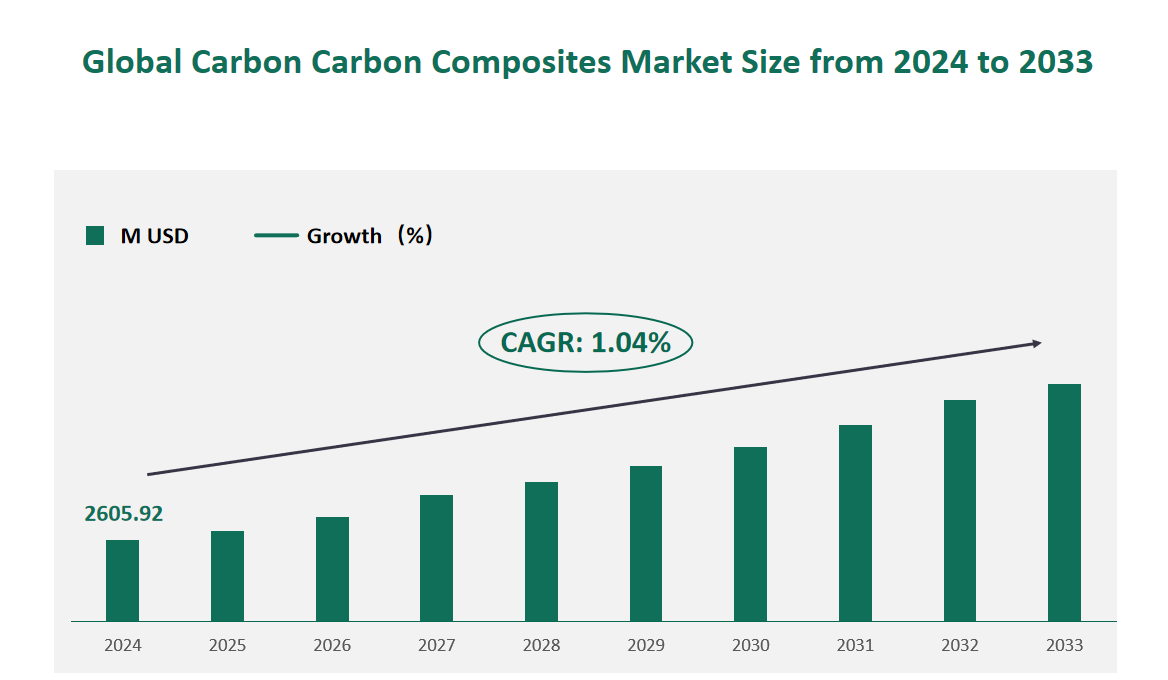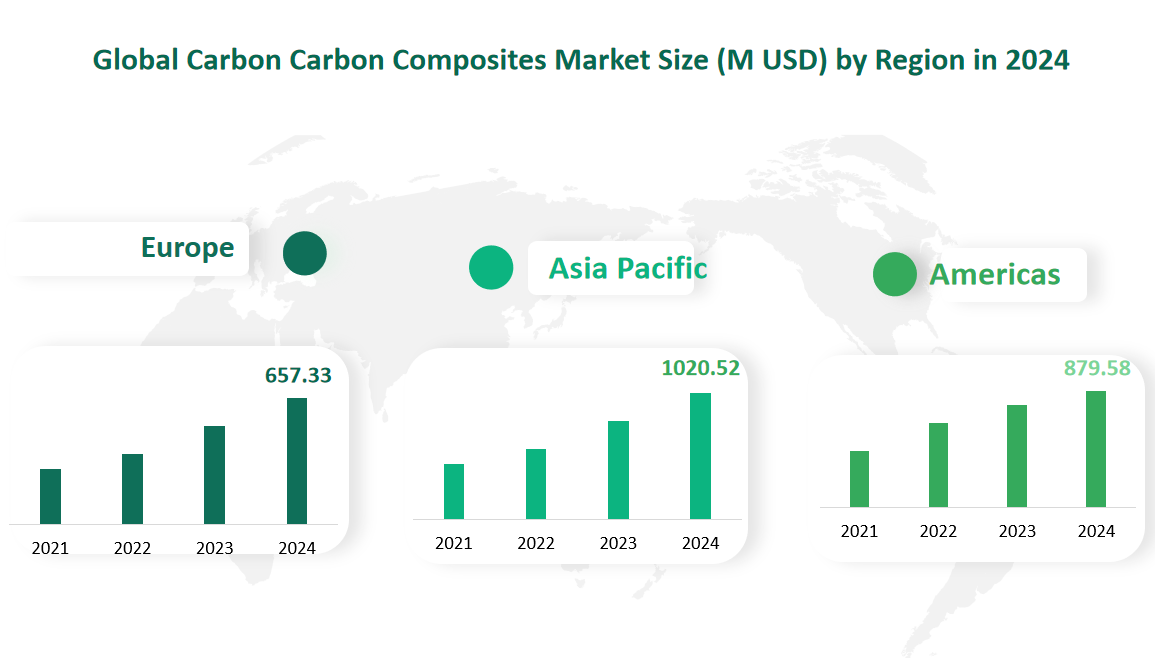1 Global Carbon Carbon Composites Market Size (Value) and CAGR (2024-2033)
In 2024, the global Carbon Carbon Composites market was valued at USD 2605.92 million, with a CAGR of 1.04% from 2024 to 2033.
Carbon Carbon composites are composite materials composed of carbon fibers and matrix phases (such as coke, sintered carbon and graphite) and have the characteristics of low density, high mechanical strength, high thermostability, high electrical conductivity, high thermal conductivity, low CTE, excellent fracture toughness and high friction/wear resistance. It can be used in defense, aerospace, automotive and other fields.
Figure Global Carbon Carbon Composites Market Size (M USD) and CAGR 2024-2033

2 Carbon Carbon Composites Market Drivers
Increasing Demand from Aerospace and Defense: The aerospace and defense sectors are major consumers of Carbon Carbon Composites. These industries require materials that can withstand extreme temperatures and mechanical stress while maintaining low weight. Carbon Carbon Composites are ideal for applications such as rocket nozzles, aircraft brake discs, and thermal protection systems. The continuous development and innovation in aerospace technology, coupled with the increasing number of space missions and defense projects, drive the demand for these high-performance materials.
Growth in the Photovoltaic Industry: The photovoltaic (PV) industry is another significant driver of the Carbon Carbon Composites market. With the global push towards renewable energy, the demand for solar panels has increased dramatically. Carbon Carbon Composites are used in the manufacturing of silicon ingots and wafers, which are essential components of solar panels. The thermal stability and high strength of these composites make them suitable for high-temperature processes involved in PV production. As the PV industry continues to expand, the demand for Carbon Carbon Composites is expected to grow accordingly.
Technological Advancements: Continuous advancements in material science and manufacturing processes have led to the development of more efficient and cost-effective Carbon Carbon Composites. These advancements have improved the performance and reliability of the composites, making them more attractive to various industries. Additionally, the development of new applications and the enhancement of existing ones have broadened the market potential for Carbon Carbon Composites.
Government Policies and Support: Governments around the world are increasingly supporting the development of high-tech materials and renewable energy sources. Policies aimed at reducing carbon emissions and promoting sustainable energy have led to increased investment in the photovoltaic and aerospace industries. This support has indirectly benefited the Carbon Carbon Composites market by creating a favorable environment for growth and innovation.
3 Carbon Carbon Composites Market Restraints
High Production Costs: The production of Carbon Carbon Composites involves complex and energy-intensive processes. The high cost of raw materials, coupled with the need for advanced manufacturing technologies, results in elevated production costs. This makes the composites relatively expensive compared to traditional materials, limiting their adoption in some applications.
Technical Barriers: The production of Carbon Carbon Composites requires specialized knowledge and expertise. The processes involved, such as chemical vapor deposition and liquid impregnation, are technically challenging and require significant investment in research and development. New entrants to the market face high barriers to entry due to the complexity of these processes and the need for substantial capital investment.
Supply Chain Constraints: The supply chain for Carbon Carbon Composites is relatively complex and can be subject to disruptions. The availability of high-quality raw materials is crucial for the production of these composites. Any fluctuations in the supply of these materials can impact production schedules and costs. Additionally, the global nature of the supply chain makes it vulnerable to geopolitical issues and trade restrictions.
4 Global Carbon Carbon Composites Market Consumption (Tons) by Type in 2024
Chemical Vapor Deposition is a process where carbon is deposited onto a carbon fiber preform by the pyrolysis of hydrocarbons such as methane and propylene at high temperatures. This method is used to achieve densification of the carbon fiber preform, resulting in a carbon/carbon composite material with high purity and strength. In 2024, the CVD segment is expected to consume 10,424 tons, accounting for approximately 53.59% of the total market. This type is widely used in high-temperature applications, particularly in the aerospace and defense industries, where materials need to withstand extreme conditions.
The Liquid Impregnation Process involves immersing the carbon fiber preform into a liquid impregnant. Through vacuum, pressure, and other measures, the impregnant penetrates the pores of the preform. The material then undergoes curing, carbonization, and graphitization processes to produce the final carbon/carbon composite. In 2024, this segment is projected to consume 8,102 tons, representing about 41.65% of the total market. This type is commonly used in applications such as aerospace components, automotive parts, and industrial furnaces, where its high strength and thermal stability are advantageous.
Table Global Carbon Carbon Composites Market Consumption (Tons) by Type in 2024
Type | Market Consumption (Tons) 2024 | Market Share 2024 |
Chemical Vapor Deposition | 10424 | 53.59% |
Liquid Impregnation Process | 8102 | 41.65% |
Others | 926 | 4.76% |
5 Global Carbon Carbon Composites Market Consumption (Tons) by Application in 2024
In the realm of applications, Carbon Carbon Composites play a crucial role in CZ and DSS Furnaces, with an estimated consumption of 6,277 tons in 2024, accounting for 32.27% of the total market. These composites are essential for the production of single crystal silicon through processes like Czochralski (CZ) and Directional Solidification System (DSS), where their high thermal stability and strength are indispensable. The photovoltaic and semiconductor industries, which are experiencing rapid growth, drive the demand for these composites in furnace components.
Another significant application is in C/C Grid Shelving Systems, which are projected to consume 1,862 tons in 2024, representing 9.57% of the market. These systems are used in high-temperature industrial applications, such as glass and ceramic manufacturing, where the composites’ thermal resistance and strength are critical. The Glass Handling Industry also benefits from Carbon Carbon Composites, with an estimated consumption of 1,102 tons in 2024, making up 5.66% of the market. Components like inserts, pickups, and sweep-out fingers rely on these composites for their thermal stability and resistance to wear.
The Aerospace sector is a major consumer of Carbon Carbon Composites, with an estimated consumption of 9,424 tons in 2024, accounting for 48.44% of the market. Components such as rocket nozzles, aircraft brake discs, and thermal protection systems leverage the composites’ high strength, low weight, and thermal stability. These properties make Carbon Carbon Composites ideal for aerospace applications, where performance and reliability are paramount.
Table Global Carbon Carbon Composites Market Consumption (Tons) by Application in 2024
Application | Market Consumption (Tons) 2024 | Market Share 2024 |
CZ and DSS Furnaces | 6277 | 32.27% |
C/C Grid Shelving Systems | 1862 | 9.57% |
Glass Handling Industry | 1102 | 5.66% |
Aerospace Items | 9424 | 48.44% |
Others | 788 | 4.05% |
6 Global Carbon Carbon Composites Market Size by Region in 2024
The Asia Pacific region is the largest market for Carbon Carbon Composites, with a projected value of 1,020.52 million USD in 2024, accounting for 39.16% of the global market. This region’s rapid industrialization and technological advancements, particularly in countries like China and Japan, drive the demand for these composites. China is a major producer and consumer, contributing significantly to the regional market value. The growing photovoltaic and semiconductor industries in the region further boost the demand for Carbon Carbon Composites.
The Americas, particularly the United States, are significant players in the Carbon Carbon Composites market, with a projected value of 879.58 million USD in 2024, representing 33.75% of the global market. The region’s strong aerospace and defense industries drive the demand for high-performance materials. The United States is a leader in technological advancements and innovation, contributing to the region’s substantial market share.
Europe’s market is characterized by strong demand from the aerospace and automotive industries, with a projected value of 657.33 million USD in 2024, accounting for 25.22% of the global market. Countries like Germany, France, and the UK are key players in the region. Europe’s focus on high-tech manufacturing and sustainable energy projects supports the growth of the Carbon Carbon Composites market.
Figure Global Carbon Carbon Composites Market Size by Region in 2024

7 Major Players in Global Carbon Carbon Composites Market
7.1 KBC
Company Profile: KBC, established in 2005, is headquartered in China. The company is primarily engaged in the research and development, production, and sales of advanced carbon matrix composite materials and products, with a focus on carbon/carbon composite materials. KBC’s products are mainly used in the photovoltaic industry for crystal silicon manufacturing thermal field systems. The company’s sales region is primarily within China.
Business Overview: KBC specializes in carbon/carbon composite materials, which are critical for high-temperature applications in the photovoltaic industry. The company’s products are designed to withstand extreme temperatures and provide superior thermal stability, making them ideal for use in crystal silicon manufacturing processes. KBC’s commitment to innovation and quality has positioned it as a leading player in the market.
Type Introduction: KBC offers a range of carbon/carbon composite products, including crucibles used in high-temperature vacuum furnaces. These products are designed to meet the stringent requirements of the photovoltaic industry, ensuring high efficiency and reliability in silicon ingot and wafer production.
Recent Financial Data: In the most recent year, KBC reported a production volume of 2,298 tons, with a market value of 250.57 million USD.
7.2 SGL Carbon
Company Profile: SGL Carbon, established in 1992 and headquartered in Germany, is a global leader in graphite and carbon composite materials. The company’s products are used in a variety of industries, including automotive, aerospace, solar, and wind energy, as well as in the manufacturing of semiconductors, LEDs, and lithium-ion batteries. SGL Carbon’s sales region primarily covers Europe, the Middle East, and Africa.
Business Overview: SGL Carbon’s business is centered around the production and sale of high-performance carbon and graphite materials. The company’s products are known for their lightweight, high-strength, and thermal stability, making them suitable for demanding applications in various industries. SGL Carbon’s commitment to innovation and sustainability has helped it maintain a strong market position.
Type Introduction: SGL Carbon offers a wide range of carbon composite products, including SIGRABOND Carbon Fiber-Reinforced Carbon. These materials are designed for high-temperature applications and are known for their reliability and performance. The company’s product portfolio includes heating elements, furnace linings, and other components used in high-temperature processes.
Recent Financial Data: In the most recent year, SGL Carbon reported a production volume of 537 tons, with a market value of 136.49 million USD.
7.3 Hexcel
Company Profile: Hexcel, established in 1948 and headquartered in the USA, is a leading producer of carbon fiber reinforcements and resin systems. The company is also a world leader in honeycomb manufacturing for the commercial aerospace industry. Hexcel’s sales region includes North America, Europe, and Asia Pacific.
Business Overview: Hexcel specializes in the production of advanced composite materials, including carbon fiber reinforcements and resin systems. The company’s products are used in a variety of industries, including aerospace, automotive, and industrial applications. Hexcel’s commitment to innovation and quality has positioned it as a key player in the global Carbon Carbon Composites market.
Type Introduction: Hexcel offers a comprehensive range of carbon fiber reinforcements, including HexForce® woven carbon fabrics. These materials are designed to provide high strength and thermal stability, making them suitable for demanding applications in the aerospace and industrial sectors. The company’s product portfolio includes traditional fabrics, flat-tow fabrics, and heat-set-uni fabrics.
Recent Financial Data: In the most recent year, Hexcel reported a production volume of 374 tons, with a market value of 110.94 million USD.

